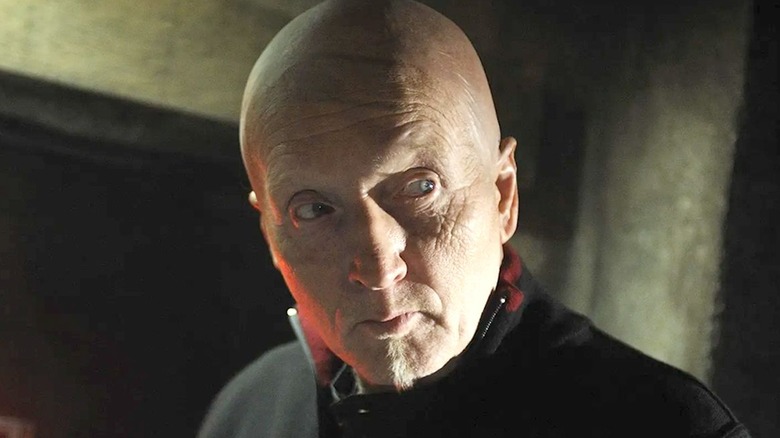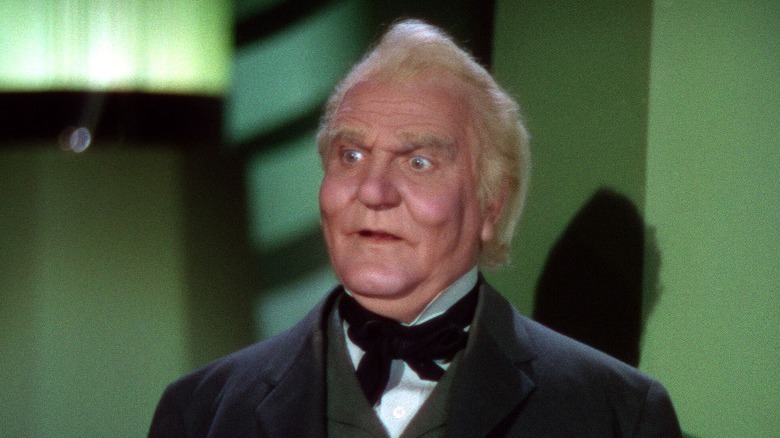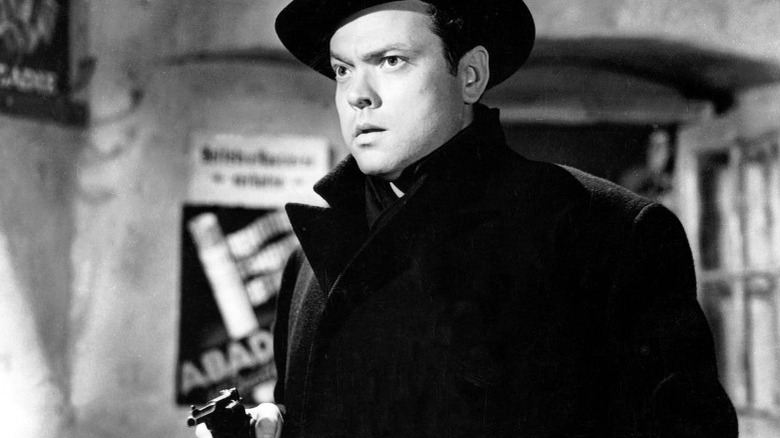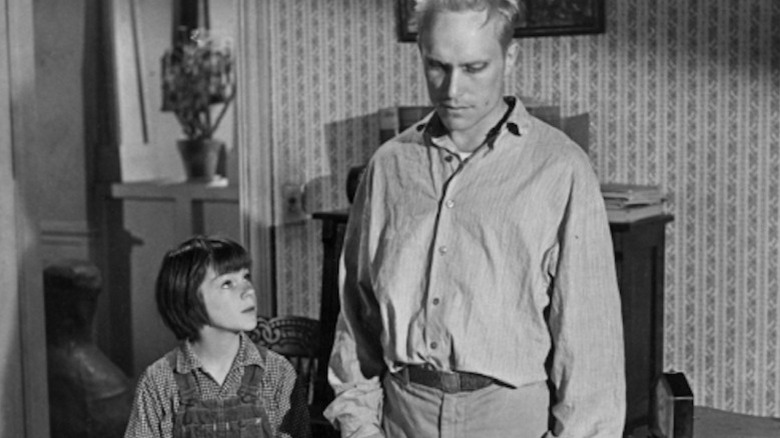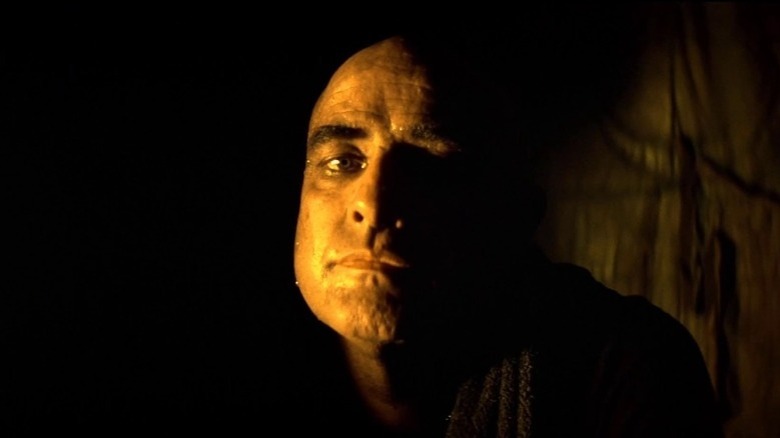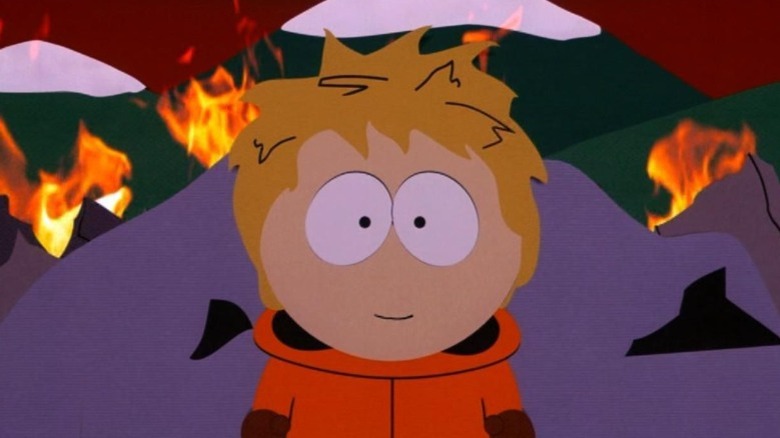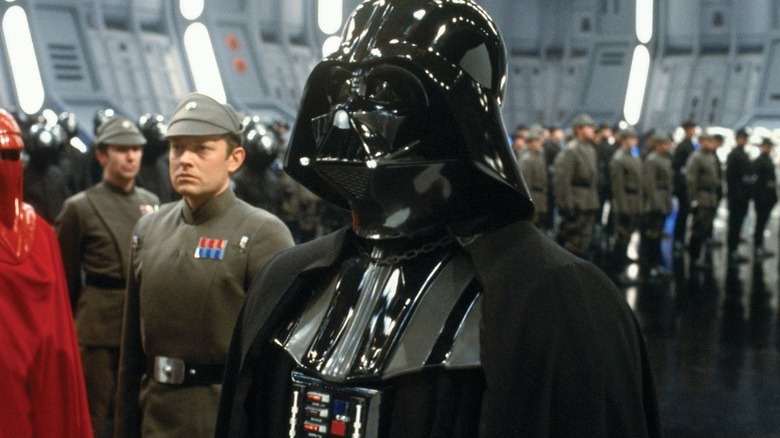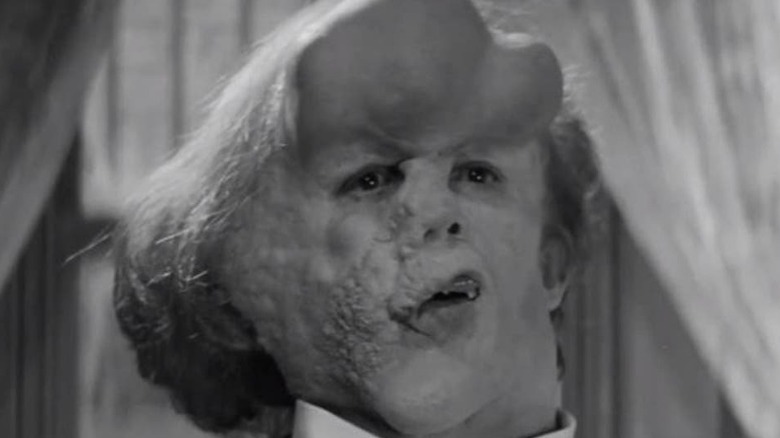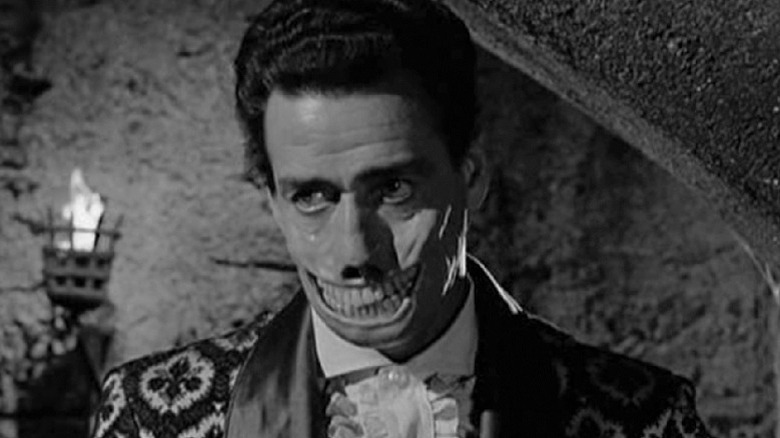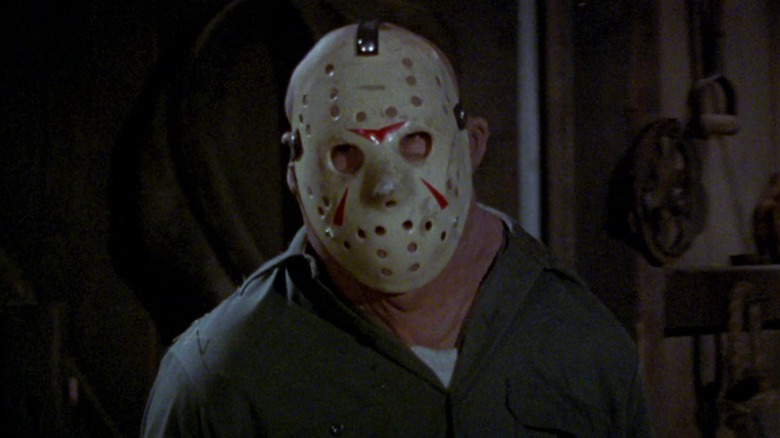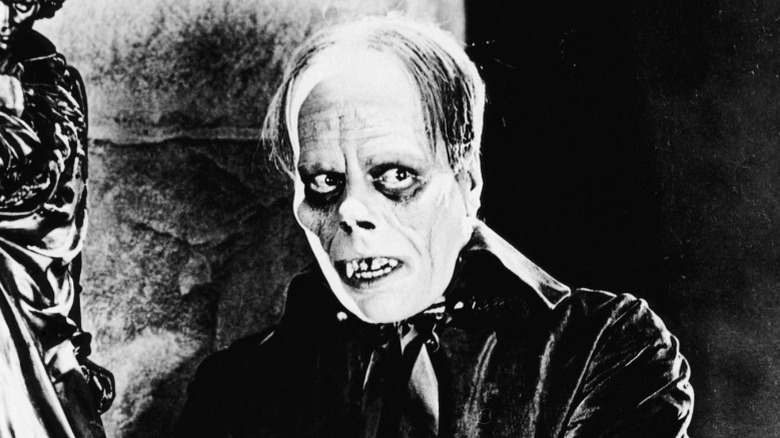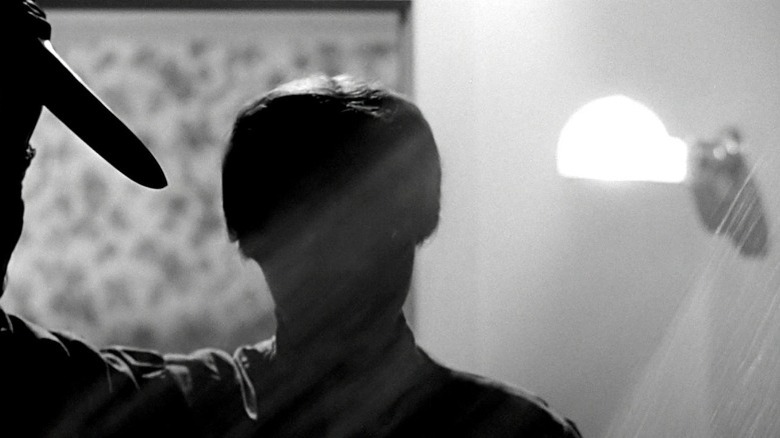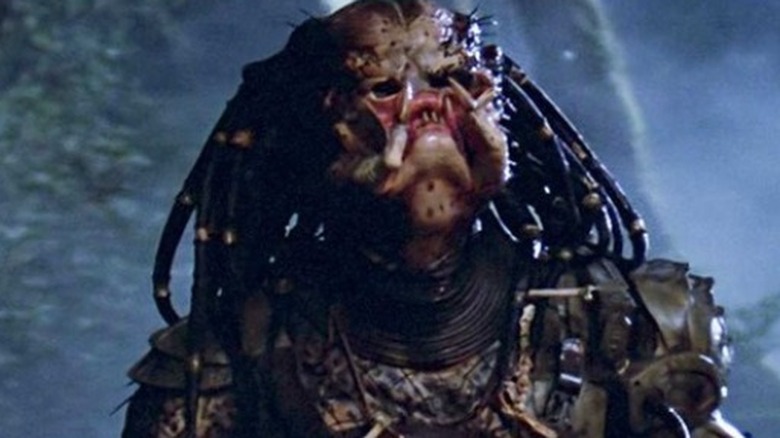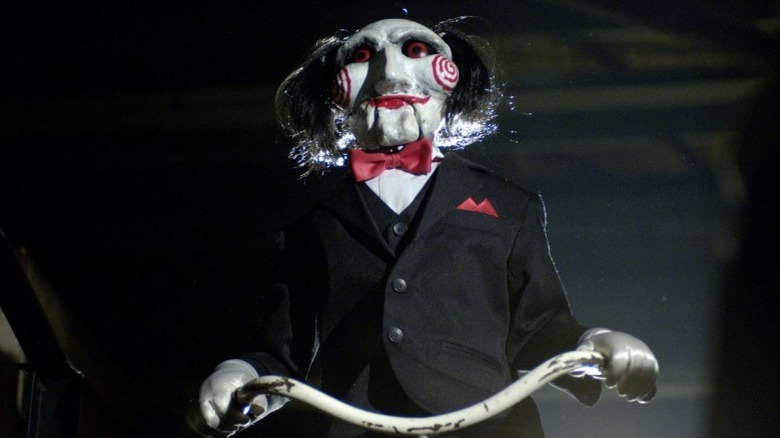The Best Face Reveals In Movie History
There's something so marvelous about a great reveal — building up audience suspense towards a great surprise, then dropping one that shocks the viewer and makes them reassess everything they know thus far, head swimming in newfound revelation. It could be a subtle moment or a dramatic reveal, and there's nothing quite like being in a theater and hearing the gasps, sounds of disbelief, or full-on screams as an entire audience is floored by a plot twist nobody saw coming. Sure, sometimes a twist can actually ruin an entire film, but when it is done right, a good twist is hard to beat.
With film being a visual medium, some of the best surprises in the history of cinema are visual, revealing the face of a mysterious character. Oftentimes, that means revealing the identity of a masked killer, but there are plenty of other, ingenious ways to reveal a character's true motivations for dramatic, emotional. The films listed below encompass a wide range of genres and decades, spanning nearly the entire history of cinema. Here are the best face reveals in movie history.
The Wizard (The Wizard of Oz)
"We're off to see the Wizard, the wonderful Wizard of Oz," sing Dorothy (Judy Garland) and her companions as they trot down the yellow brick road. The film, "The Wizard of Oz" — beloved for its tremendous music, stunning transition into color, and the Oscar-winning "Somewhere Over the Rainbow" — follows Dorothy Gale, who ends up in the magical land of Oz after a tornado in her native Kansas. Her only way back lies in Emerald City, where a powerful Wizard can return her home. On the way, she meets the Scarecrow (Ray Bolger), the Tin Man (Jack Haley), and the Cowardly Lion (Bert Lahr), who all seek help from the almighty Wizard.
Despite everyone knowing of the Wizard, and him constantly being referenced in the film, nobody has ever seen the mighty man in person. The same is true of the film's audience, who only see the Wizard of Oz near the end of the film. Dorothy and pals have finally made it to Emerald City, and their meeting with the Wizard is a frightening experience. His deep, booming voice and green floating head make him feel like something out of a nightmare. Dorothy's dog Toto pulls back an emerald curtain, revealing a regular man pretending to be far mightier than he is — nearly a century later, the phrase "pull back the curtain" is still shorthand for a revelation of the truth. Thankfully for the gang, the Wizard does have some considerable wisdom and helps them see the greatness within each of them, even if he isn't all-powerful.
Harry Lime (The Third Man)
Writer Holly Martins (Joseph Cotton) arrives in post-war Vienna without a penny to his name, at the request of his childhood friend Harry Lime. When Martins arrives, however, it turns out Lime is dead. He hears of a theory about a mysterious third man, present at the time of Lime's death, and sets out to discover the truth, all the while falling in love with Lime's devastated lover Anna (Alida Valli).
Director Carol Reed's "The Third Man" is a miraculous piece of cinema for many reasons, dripping with atmosphere and mood, and Anton Karas' sensational zither score (so iconic you can hear the Beatles play it in Peter Jackson's "Get Back" documentary) provides the perfect backdrop to Vienna. Lime is spoken about so often that you can practically visualize him yourself, but he is never seen. That is, until a dramatic moment halfway through the film reveals that Harry Lime is not only alive and well, but played by Orson Welles. Welles reveals a devilish smile before the lights go off, and he disappears yet again. It's simply unforgettable.
The film is every bit as impactful today as it was in 1949, and perhaps that's why filmmaker Martin Scorsese has called the moment "The best revelation – or the best reveal, as they say – in all of cinema."
Boo Radley (To Kill A Mockingbird)
Boo Radley is certainly a well-known name, as "To Kill A Mockingbird" has been read by countless students all over the world. The novel by Lee Harper won a Pulitzer Prize and was voted America's most loved book in the PBS Great American Reads survey. Shortly after it was published in 1960, the movie rights were snapped up and the "To Kill A Mockingbird" film was released in 1962, bringing the heroics of Atticus Finch (Gregory Peck) to the silver screen. The film was a huge hit, earning eight Oscar nominations and winning three, including Best Actor for Peck.
Throughout the film, the children talk about Boo Radley (Robert Duvall), a man who only leaves his house at night. The children prophesize Radley as if he's some sort of scary ghost, which is supported by all the negative town gossip that circulates about him, not afraid to refer to Radley as a "maniac". On Halloween eve, Scout (Mary Badham) and Jem (Phillip Alford) are attacked and in grave danger, but they are saved by a mysterious man. In a memorable scene where the man is hiding behind a door, cloaked in shadow, the door is pulled back, removing the shadow, and revealing Boo Radley himself, Scout's savior. The scene is a vital reminder of the film's core message: you cannot judge a book by its cover.
Colonel Kurtz (Apocalypse Now)
The 1970s was a decade largely dominated by Francis Ford Coppola. He won five Oscars, for writing "Patton" and for his work on "The Godfather" and "The Godfather Part 2." He also won the prestigious Palme d'Or at the Cannes Film Festival for "The Conversation," released the same year as the second "Godfather." On top of all this, Coppola closed out the '70s with "Apocalypse Now," an epic Vietnam war movie notorious for its difficult shoot, one that really pushed Coppola to the limit.
During the Vietnam War, U.S. Army Captain Benjamin Willard (Martin Sheen) is given instructions to find Colonel Walter Kurtz (Marlon Brando), and eliminate him. Or rather, "terminate Colonel Kurtz's command ... terminate with extreme prejudice." Kurtz has lost his mind and has started to wage a war of his own, commanding a Cambodian outpost comprised of American and indigenous Vietnamese militia who worship him. Kurtz is constantly mentioned but never seen, until the final act. When Willard finally discovers Kurtz, the two converse, with Kurtz largely shrouded in shadow. Eventually, Kurtz's entire face is revealed, emerging from the darkness, one of cinema's great images.
Kenny McCormick (South Park: Bigger, Longer & Uncut)
Poor, poor Kenny. There are few characters in television history with worse fortune than Kenny McCormick from "South Park," who died in almost every episode in the early seasons of the show. Kenny has bitten the dust well over 100 times, as breathlessly documented by various compilations of his deaths on YouTube.
These days, Kenny has storylines of his own and dies far less often — and although the risk of his demise is always around the corner, it may have become hard to remember a time when one of the biggest questions in pop culture was what, exactly, this ill-lucked child looked like beneath his big orange parka hood. Despite being a sensation for over two years, as of 1999 Kenny's whole face had never been seen.
That is, until "South Park" hit the big screen via "South Park: Bigger, Longer & Uncut," an Oscar-nominated (Best Song: "Blame Canada") breakthrough that had the ribald series brilliantly navigating the oft-treacherous move from small screen to big. In the film, Kenny manages to stop an escalating war between Canada and America, damning him to an eternity in hell. Before returning to the fiery pits, Kenny says goodbye to his friends, finally taking off his hood, saying "Goodbye, you guys" before fading away forever. Who knew all it took to finally see the beloved character was eternal damnation?
Darth Vader (Return of the Jedi)
Fans of the "Star Wars" franchise are always ready for a twist, especially after "The Empire Strikes Back" delivered one of the most shocking reveals of all time with a single line: "I am your father." Despite the revelation, audiences still had no idea what the indomitable Darth Vader looked like behind his dread-inducing mask and cape. That mystery would finally be revealed in the conclusion to the epic original trilogy, "Return of the Jedi." Fans would finally have the opportunity to see what Darth Vader — the third-greatest villain of all time according to the American Film Institute — really looked like.
After a legendary lightsaber duel between Luke Skywalker (Mark Hamill) and Vader, Luke severs Vaders hand, and the Emperor (Iain McDiarmid) implores that Luke finish off Vader and take his place. When Luke refuses, the Emperor assaults him with Force lightning, which would kill him — if not for the intervention of Vader, who crosses the Emperor by throwing him down a reactor shaft. The decision fatally electrocutes Vader, but he hangs on long enough for a tender moment between himself and his son. It's rather shocking to see the seemingly invincible Vader so vulnerable, but it provides a vital human element to the character, and is a big part of why Vader has remained an iconic villain for decades.
John Merrick (The Elephant Man)
While face reveals are often associated with the horror and thriller genres — the reveals often answer the burning question of who is behind grisly murders — sometimes the best face reveals come in emotional dramas. That's not necessarily the sort of film we've all come to expect from director David Lynch, but "The Elephant Man" is exactly that. The film tells the true story of John Merrick (played by John Hurt), a man with severe physical deformities. He was exhibited at freakshows and dubbed the Elephant Man, before meeting Dr. Frederick Treves (Anthony Hopkins), who brought him to live at the London Hospital so he could receive proper care.
Throughout the film, Merrick wears a bag over his head to obscure his appearance, and at other times is obscured by shadow. Cleverly, the reveal is not built up but actually happens rather suddenly and by chance. When a nurse enters his hospital room, his appearance is fully revealed, and we see the full extent of why people call him the Elephant Man. What's so great about the film, and the reveal, is the acknowledgement of Merrick's character. We see the unbearable treatment he receives, and when he is crowded by countless onlookers, he screams "I am not an animal ... I am a human being!" It's an unforgettable moment that speaks to the film's tender heart and thoughtful treatment of a misunderstood man.
Mr. Sardonicus (Mr. Sardonicus)
William Castle became a force in the world of B-movies at a young age, honing his craft and garnering a reputation for his ability to create profitable films with remarkable speed and on budget. Castle also developed a passion for cinema gimmicks as a form of self-promotion (as detailed in the 1993 John Goodman film "Matinee," which features a Castle-like protagonist). For example, for "The Tingler", Castle had a crew install buzzers under cinema seats to terrify audiences, encouraging audience members to scream if they feel the "tingling".
For 1961's "Mr. Sardonicus," Castle upped the ante by allowing audiences to vote on the villain's fate via a "punishment poll," which involved a glow-in-the-dark card with a thumb they could hold up or down to decide Mr. Sardonicus' fate. The film's terrifying reveal comes when we see Mr. Sardonicus' face, which has become frozen in a skin-crawling grin after he robbed his own father's grave to get a winning lottery ticket. The sinister Sardonicus typically hides his face behind an unsettling mask, but his horrible smile is finally revealed in flashback. Castle plays with shadow beautifully as he suddenly reveals Mr. Sardonicus' new face to his love Elenka, who takes her own life after glimpsing her husband's horrific visage.
Jason Voorhees (Friday the 13th Part III)
The "Friday the 13th" franchise is no stranger to twists — this is, after all, the franchise that gave us one of the all-time iconic horror movie endings in its very first film. When we caught up with Jason (Richard Brooker) in "Friday the 13th Part II," the slasher had donned a rather hideous sack over his face, which only had one hole for a single eye. The legendary hockey mask wouldn't actually make its debut until "Friday the 13th Part III."
For three films, the mystery of what Jason looked like under these obfuscations continued to grow, but in 1982's "Part III," we finally got a glimpse of what remained of the man behind the mask. In a brutal showdown, final girl Chris Higgins (Dana Kimmell), battling it out with Jason, would manage to knock him out with a shovel and hang him with a rope.
This being Jason Vorhees, of course he is still alive. Instead of Chris removing his mask, Jason removed it himself, revealing his hideously disfigured face, resulting in a shriek of horror from his intended victim. While the series has never been afraid to rely on predictability, finally getting to see Jason's face was a real shocker for audiences.
Erik (The Phantom of the Opera)
Few actors in history have ever been as dedicated as Lon Chaney. Known as "The Man of a Thousand Faces," Chaney underwent massive physical changes for many of his roles. In 1923's "The Hunchback of Notre Dame," Chaney wore an extremely heavy hump on his back, and in 1927's "The Unknown" (also starring a young Joan Crawford), Chaney hid his arms for hours on end to get into character. Perhaps Chaney's most remarkable transformation, however, can be seen in 1925's "The Phantom of the Opera," with Chaney cast as the titular Phantom, Erik.
Erik hides in a subterranean lair below the Paris Opera House, falling in love with opera singer Christine (Mary Philbin). When Christine discovers a secret door, she finds her way down to the depths in which Erik hides. Fully masked, he finally encounters her and declares his love, causing Christine to faint. Erik takes her into a room and informs her that she is free to come and go as she likes, albeit with one rule: She must never look under his mask. Christine ignores the rule, sneaking up behind Erik and revealing his deformed, skeletal face, screaming in horror at what she has unveiled. The reveal is the stuff of legend — reportedly, it was so extreme that audiences in 1925 had cases of people fainting from the terror.
Mrs. Bates (Psycho)
Alfred Hitchcock's "Psycho" floored audiences when it was released in cinemas in 1960, which is no surprise, considering the film was made by the master of suspense. The film was chock-full of shocks and surprises, one of the biggest being the famous shower scene, a moment so essential to film that an entire documentary was made about it. The shower scene was also a huge moment because the presumed main character of "Psycho," Marion Crane (Janet Leigh) was killed in the first half of the film, upending audience expectations. The scene was so frightening that Leigh never took a shower again — yet, the shadowy way the murderer was filmed left a mystery, though the silhouette certainly pointed to the (unseen but much-discussed) Mrs. Bates.
Throughout the film, Mrs. Bates continued to be shown in silhouette — or from up top, or behind — with the audience hearing her voice far more often than seeing her actual body. Hitchcock's stunning reveal of Mrs. Bates comes at the end of the film, as Marion's sister Lila (Vera Miles) is investigating the disappearance of her sister; Mrs. Bates appears to be in the basement, facing the wall.
When Vera turns her around, she makes a stunning discovery: Mrs. Bates is long dead. Vera turns around to discover that the "Mrs. Bates" who murdered her sister is none other than her son Norman (Anthony Perkins); it's one of cinema history's most iconic reveals, but the clues were there all along. After all, as Norman says, "A boy's best friend is his mother."
Predator (Predator)
What was supposed to be a fairly straightforward hostage rescue mission in Central America turns into a horrifying nightmare in 1987's "Predator." Major Dutch (Arnold Schwarzenegger) and his rescue team are tasked with recovering a foreign cabinet minister and his aide, as the pair have been kidnapped by insurgents. On the way to the rescue site, the team finds some badly deformed corpses. After they reach the guerilla camp, CIA agent Al Dillon (Carl Weathers) informs Dutch that the real mission was to stop an invasion — and they realize they are being stalked by a mysterious presence employing some sort of cloaking device.
The alien Predator is invisible for much of the film, making it particularly frightening when we finally do see the Predator in physical form, wearing a sleek combat mask. Predator is no joke; he possesses tremendous strength, thermal imaging, and an arsenal of impressive weaponry. After killing most of his targets, the Predator wants to go toe to toe — or rather, hand to hand, with Dutch. In doing so, he removes his mask, revealing a truly grotesque alien face, complete with snarling external teeth.
Jigsaw (Saw)
"I want to play a game" are words that have become synonymous with the "Saw" franchise, which has blossomed from a small independent horror flick with a $1.2 million budget to a nine-movie franchise. This is entirely thanks to the success of 2004's "Saw," which introduced us to Jigsaw, a serial killer who took delight in having victims torture themselves. Jigsaw employs elaborate torture devices to put his victims in, essentially forcing them into making excruciating choices that inevitably doom themselves, perhaps none more memorable than the reverse bear trap.
Throughout the original film, we see a terrifying pig mask in videos that give the victims instructions, which makes viewers believe that Jigsaw is the man behind the mask. Most of the film takes place in a single room, a disgusting, bloody bathroom, where Adam (Leigh Whannell) and Lawrence (Cary Elwes) are chained to different corners. In the middle is a man who has shot himself, lying in a pool of his own blood.
As the detectives get closer to finding who they think is Jigsaw, the very end of the film gave audiences one of the most shocking reveals in horror history. Not only is the suspected killer not Jigsaw, but it turns out that the "dead man" (Tobin Bell) has been the mastermind of this game all along.
As the music swells and the horrific gears grind, the man sits up and finally reveals himself as Jigsaw. It was a moment that instantly burned itself into the minds of audiences, and that iconic reveal is why the original "Saw" remains the best entry in the entire franchise.
